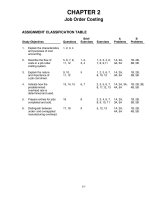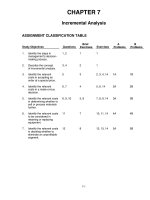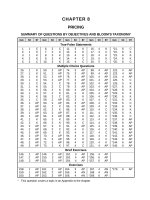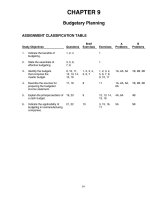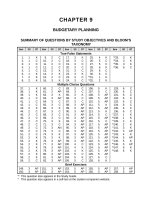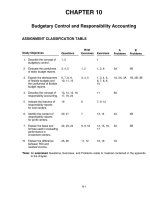Test bank financial accounting 5th 5e
Bạn đang xem bản rút gọn của tài liệu. Xem và tải ngay bản đầy đủ của tài liệu tại đây (162.39 KB, 50 trang )
Testbank
to accompany
Financial Accounting:
Reporting, Analysis and
Decision Making 5e
by
Carlon et al.
© John Wiley & Sons Australia, Ltd 2016
Testbank to accompany Financial Accounting: Reporting, Analysis and Decision Making 5e
Chapter 1: An introduction to accounting
Multiple-choice questions
1. The provision of accounting information within the business entity is referred to as:
a. financial accounting.
*b. management accounting.
c. commercial accounting.
d. public accounting.
Answer: b
Learning objective 1.1 – Explain the business context and the need for decision
making.
Feedback: The provision of information within the business entity is referred to as
management accounting.
2. The accounting process includes which steps:
*a. identifying, measuring, recording and communicating.
b. identifying, recording, communicating and justifying.
c. measuring, adjusting, recording and communicating.
d. measuring, evaluating, recording and communicating.
Answer: a
Learning objective 1.2 – Define accounting, describe the accounting process and
define the diverse role of accountants.
Feedback: The four steps of the accounting process are identifying, measuring,
recording and communicating relevant transactions and events.
3. The sole trader form of business organisation:
a. must have at least two owners.
b. combines business records with the personal records of the owner.
*c. results in the owner having personal liability for the debts of the business.
d. is a separate legal entity.
Answer: c
Learning objective 1.3 – Explain the characteristics of the main forms of business
organisation.
Feedback: Under the sole trader business structure the owner of the business has no
separate legal existence from the business. The owner of the business is therefore
personally liable for the debts of the business.
1.2
© John Wiley & Sons Australia, Ltd 2016
Chapter 1: An introduction to accounting
4. The majority of business in Australia is transacted by:
a. sole traders.
b. partnerships.
c. government units.
*d. companies.
Answer: d
Learning objective 1.3 – Explain the characteristics of the main forms of business
organisation.
Feedback: The majority of business in Australia is transacted by companies.
5. One advantage of the company form of business structure is that:
a. it has limited life.
b. the liability of the owners is unlimited.
*c. it provides the owners with shared control.
d. it makes higher profits.
Answer: c
Learning objective 1.3 – Explain the characteristics of the main forms of business
organisation.
Feedback: A company is a separate legal entity and has an indefinite life that is
independent of the shareholders. Shareholders of most companies have limited liability
for the debts of the company and if there is more than one director, the decision making
is usually a shared responsibility.
6. A company has the following set of characteristics:
a. provides owners with shared control, simple to establish.
b. simple to set up, owner retains control.
*c. complex to set up, provides owners with shared control.
d. provides owners with shared control, unlimited liability.
Answer: c
Learning objective 1.3 – Explain the characteristics of the main forms of business
organisation.
Feedback: There are initial costs associated with incorporation for a company and
then ongoing fees and regulations to comply with. If there is more than one director,
then the decision making is usually a shared responsibility. Shareholders of most
companies have limited liability for the debts of the company.
1.3
© John Wiley & Sons Australia, Ltd 2016
Testbank to accompany Financial Accounting: Reporting, Analysis and Decision Making 5e
7. Which of the following statements is false?
*a. The definition of reporting entity forms the foundation of the Conceptual
Framework as all other elements flow from it.
b. A reporting entity must prepare general purpose financial reports that comply with
accounting standards.
c. Political or economic importance is a factor in determining whether an entity is a
reporting entity.
d. The objective of general purpose financial reports is to provide information that is
useful to existing and potential investors, creditors and other external users.
Answer: a
Learning objective 1.4 – Understand the Conceptual Framework and the purpose of
financial reporting.
Feedback: The objective of general purpose reporting forms the foundation of the
Conceptual Framework. If we know why we need to report then who needs to report
can be determined and then what and how the information is to be reported follow. All
the other statements are correct.
8. The purpose of financial reports is to:
*a. provide information for decision making.
b. report profit.
c. pay tax to the ATO.
d. report to the bank.
Answer: a
Learning objective 1.4 – Understand the Conceptual Framework and the purpose of
financial reporting.
Feedback: The purpose of financial reports is to provide information for decision
making.
9. Who of the following would not be considered an internal user of accounting data
for the XYZ Company Ltd?
a. the chief executive officer of the company.
b. a production manager.
c. the company's sales manager.
*d. a share investor.
Answer: d
Learning objective 1.5 – Identify the users of financial reports and describe users'
information needs.
Feedback: Internal users of accounting information are managers who plan, organise
and control the business.
1.4
© John Wiley & Sons Australia, Ltd 2016
Chapter 1: An introduction to accounting
10. Which of the following user groups would use accounting information to determine
whether an advertising proposal will be cost effective?
a. investors in shares.
*b. marketing managers.
c. creditors.
d. chief financial officer.
Answer: b
Learning objective 1.5 – Identify the users of financial reports and describe users'
information needs.
Feedback: Evaluating an advertising proposal would occur internally and would
typically be undertaken in the marketing department.
11. Which of the following user groups is an internal user of accounting information
for the XYZ Company Ltd?
a. auditors from the Australian Taxation Office.
*b. management of XYZ Company.
c. creditors of XYZ Company.
d. customers of XYZ Company.
Answer: b
Learning objective 1.5 – Identify the users of financial reports and describe users'
information needs.
Feedback: Managers are internal users of accounting information.
12. Which of the following users would not be considered an internal user of
accounting data for a company?
a. the chief executive officer of the company.
b. the financial director of the company.
*c. a creditor of the company.
d. a salesperson employed by the company.
Answer: c
Learning objective 1.5 – Identify the users of financial reports and describe users'
information needs.
Feedback: Creditors are an external resource provider.
1.5
© John Wiley & Sons Australia, Ltd 2016
Testbank to accompany Financial Accounting: Reporting, Analysis and Decision Making 5e
13. Which of the following is not a principal type of business activity?
a. operating.
b. investing.
c. financing.
*d. delivering.
Answer: d
Learning objective 1.5 – Identify the users of financial reports and describe users'
information needs.
Feedback: The three main types of business activities are operating, investing and
financing. Delivery is a function of operating activities.
14. Borrowing money is an example of a/an:
a. marketing activity.
*b. financing activity.
c. investing activity.
d. operating activity.
Answer: b
Learning objective 1.5 – Identify users of financial reports and describe users'
information needs.
Feedback: Borrowing money is one of the two main sources of outside funds for
companies. The other is the issue of shares to investors.
15. Buying assets required to operate a business is an example of a/an:
a. advertising activity.
b. financing activity.
*c. investing activity.
d. operating activity.
Answer: c
Learning objective 1.5 – Identify the users of financial reports and describe users'
information needs.
Feedback: Investing activities involve purchasing resources an entity needs in order to
operate.
1.6
© John Wiley & Sons Australia, Ltd 2016
Chapter 1: An introduction to accounting
16. The activity involved with employing the resources of the business to generate
revenues is:
a. accounting.
b. financing.
c. investing.
*d. operating.
Answer: d
Learning objective 1.5 – Identify the users of financial reports and describe users'
information needs.
Feedback: Once a business has acquired resources it needs to employ those resources
to generate revenues from operating activities.
17. Buying and selling products are examples of:
*a. operating activities.
b. investing activities.
c. financing activities.
d. delivering activities.
Answer: a
Learning objective 1.5 – Identify the users of financial reports and describe users'
information needs.
Feedback: Buying and selling products are examples of operating activities.
18. The common characteristic possessed by all assets is:
a. long life.
b. great monetary value.
c. tangible nature.
*d. future economic benefit.
Answer: d
Learning objective 1.6 – Identify the elements of each of the four main financial
statements.
Feedback: An asset is defined in the Conceptual Framework as a resource controlled
by the entity as a result of past events from which future economic benefits are
expected.
1.7
© John Wiley & Sons Australia, Ltd 2016
Testbank to accompany Financial Accounting: Reporting, Analysis and Decision Making 5e
19. Dividends paid:
a. increase assets.
b. increase expenses.
c. decrease revenues.
*d. decrease retained earnings.
Answer: d
Learning objective 1.6 – Identify the elements of each of the four main financial
statements.
Feedback: Retained earnings refers to company profits that have been accumulated
and not distributed as dividends to shareholders.
20. Resources owned by a business are referred to as:
a. equity.
b. liabilities.
*c. assets.
d. revenues.
Answer: c
Learning objective 1.6 – Identify the elements of each of the four main financial
statements.
Feedback: Assets are defined in the Conceptual Framework as a resource controlled
by the entity as a result of past events from which future economic benefits are
expected.
21. The financial statement that summarises the changes in retained earnings for a
specific period of time is the:
a. statement of financial position.
b. income statement.
c. statement of cash flows.
*d. statement of changes in equity.
Answer: d
Learning objective 1.6 – Identify the elements of each of the four main financial
statements.
Feedback: The statement of changes in equity reports profit for the period and
transactions with owners of the company such as share capital movements and
dividends. The statement of changes in equity explains the link between the income
statement and the statement of financial position.
1.8
© John Wiley & Sons Australia, Ltd 2016
Chapter 1: An introduction to accounting
22. Retained earnings at the end of the period is equal to:
a. retained earnings at the beginning of the period plus profit minus liabilities.
*b. retained earnings at the beginning of the period plus profit minus dividends paid.
c. profit plus total assets.
d. assets plus liabilities.
Answer: b
Learning objective 1.6 – Identify the elements of each of the four main financial
statements.
Feedback: Retained earnings refers to company profits that have been accumulated
and not distributed as dividends to shareholders.
23. A company's policy toward dividend distributions and growth could best be
determined by examining the:
a. statement of financial position.
b. income statement.
*c. statement of changes in equity.
d. statement of cash flows.
Answer: c
Learning objective 1.6 – Identify the elements of each of the four main financial
statements.
Feedback: Shareholders and other external users can see how much profit has been
distributed as dividends by reading the statement of changes in equity.
24. An income statement:
a. summarises changes in retained earnings for a specific period of time.
b. reports the changes in assets, liabilities, and equity for a specific period of time.
c. reports the assets, liabilities, and equity at a specific date.
*d. presents the revenues and expenses for a specific period of time.
Answer: d
Learning objective 1.6 – Identify the elements of each of the four main financial
statements.
Feedback: The purpose of the income statement is to report the success or failure of
the entity's operations for a period of time.
1.9
© John Wiley & Sons Australia, Ltd 2016
Testbank to accompany Financial Accounting: Reporting, Analysis and Decision Making 5e
25. If retained earnings increases from the beginning of the year to the end of the year,
then:
a. profit is less than dividends paid.
b. dividends paid are greater than profit.
c. additional investments are less than losses.
*d. profit is greater than dividends paid.
Answer: d
Learning objective 1.6 – Identify the elements of each of the four main financial
statements.
Feedback: Profits increase equity and are accumulated into retained earnings.
Dividends reduce retained earnings.
26. The statement of changes in equity does not show:
a. the beginning balance of retained earnings.
*b. total revenue.
c. the amount of dividends paid.
d. the ending balance of retained earnings.
Answer: b
Learning objective 1.6 – Identify the elements of each of the four main financial
statements.
Feedback: Total revenue is shown in the Income Statement.
27. Johnny's Car Repairs had total assets of $60,000 and total liabilities of $40,000 at
the beginning of the year. During the year the business recorded $100,000 in revenues,
$55,000 in expenses, and dividends of $10,000 were distributed. Equity at the end of
the year is:
*a. $55,000.
b. $35,000.
c. $65,000.
d. $45,000.
Answer: a
Learning objective 1.6 – Identify the elements of each of the four main financial
statements.
Feedback: Beginning equity was $20,000 ($60,000 - $40,000), profit for the year is
$45,000 ($100,000 - $55,000) therefore $20,000 + $45,000 - $10,000 = $55,000.
1.10
© John Wiley & Sons Australia, Ltd 2016
Chapter 1: An introduction to accounting
28. Johnny's Car Repairs had total assets of $60,000 and total liabilities of $40,000 at
the beginning of the year. During the year the business recorded $100,000 in revenues,
$55,000 in expenses, and dividends of $10,000 were distributed. Profit reported by
Johnny's Car Repairs for the year was:
a. $35,000
*b. $45,000
c. $20,000
d. $90,000
Answer: b
Learning objective 1.6 – Identify the elements of each of the four main financial
statements.
Feedback: Profit is $45,000 ($100,000 - $55,000).
29. If total liabilities increased by $25,000 and equity increased by $5,000 during a
period of time, then total assets:
a. decrease by $20,000.
b. increase by $20,000.
c. increase by $25,000.
*d. increase by $30,000.
Answer: d
Learning objective 1.6 – Identify the elements of each of the four main financial
statements.
Feedback: Assets = Liabilities + Equity therefore assets = $25,000 + $5,000.
30. If total liabilities decreased by $14,000 during a period of time and equity
increased by $6,000 during the same period, then the change in total assets is:
a. an increase of $14,000.
b. an increase of $20,000.
*c. a decrease of $8,000.
d. an increase of $8,000.
Answer: c
Learning objective 1.6 – Identify the elements of each of the four main financial
statements.
Feedback: Assets = Liabilities + Equity therefore assets = - $14,000 + $6,000 = $8,000.
1.11
© John Wiley & Sons Australia, Ltd 2016
Testbank to accompany Financial Accounting: Reporting, Analysis and Decision Making 5e
31. The statement of financial position:
a. summarises the changes in retained earnings for a specific period of time.
b. reports changes in assets, liabilities, and equity over a period of time.
*c. reports assets, liabilities, and equity at a specific point in time.
d. presents revenues and expenses for a specific period of time.
Answer: c
Learning objective 1.6 – Identify the elements of each of the four main financial
statements.
Feedback: The statement of financial position reports assets and claims to those assets
at a specific point in time.
32. Which of the following financial statements is concerned with a business at a point
in time?
*a. statement of financial position.
b. income statement.
c. statement of changes in equity.
d. statement of cash flows .
Answer: a
Learning objective 1.6 – Identify the elements of each of the four main financial
statements.
Feedback: The statement of financial position reports assets and claims to those assets
at a specific point in time.
33. Liabilities of a company are amounts or obligations owed to:
a. investors.
b. owners.
*c. creditors.
d. shareholders.
Answer: c
Learning objective 1.6 – Identify the elements of each of the four main financial
statements.
Feedback: Claims of creditors are called liabilities.
1.12
© John Wiley & Sons Australia, Ltd 2016
Chapter 1: An introduction to accounting
34. Equity can be described as claims of
a. creditors on total assets.
*b. owners on total assets.
c. customers on total assets.
d. auditors on total assets.
Answer: b
Learning objective 1.6 – Identify the elements of each of the four main financial
statements.
Feedback: Claims of owners are called equity or shareholders' equity.
35. Equity:
a. is always equal to cash on hand.
b. is equal to liabilities plus assets.
*c. includes retained earnings and issued shares.
d. is shown on the income statement.
Answer: c
Learning objective 1.6 – Identify the elements of each of the four main financial
statements.
Feedback: Equity of a company comprises two parts - share capital and retained
earnings.
36. Retained earnings represents:
a. the shareholders' claim on total assets.
b. the amount of cash held by the business.
c. the total of revenue for the period.
*d. the amount of profit held in the company for future use.
Answer: d
Learning objective 1.6 – Identify the elements of each of the four main financial
statements.
Feedback: Retained earnings are the accumulated profits of the company that have not
been distributed as dividends to shareholders and is available for future expansion.
1.13
© John Wiley & Sons Australia, Ltd 2016
Testbank to accompany Financial Accounting: Reporting, Analysis and Decision Making 5e
37. An annual report includes all of the following except:
a. chairman and directors' reports.
b. notes to the financial statements.
c. an auditor's report.
*d. detailed salary package of clerical staff.
Answer: d
Learning objective 1.6 – Identify the elements of each of the four main financial
statements.
Feedback: An annual report would not contain detailed information regarding the
salaries or clerical staff. This type of information is for internal decision making only
and is not available for external users.
38. The information needed to determine whether a company is using accounting
methods similar to those of its competitors would be found in the:
a. auditor's report.
b. statement of financial position.
c. directors' report.
*d. notes to the financial statements.
Answer: d
Learning objective 1.6 – Identify the elements of each of the four main financial
statements.
Feedback: The notes to the financial statements include descriptions of the accounting
policies and methods used in preparing the statements.
39. In the annual report, where would a financial statement reader find out if the
company's financial statements give a true and fair view of its financial position and
operating results?
a. notes to the financial statements.
b. directors' report.
c. statement of financial position.
*d. auditor's report.
Answer: d
Learning objective 1.6 – Identify the elements of each of the four main financial
statements.
Feedback: It is the auditor's responsibility to state whether or not the financial
statements provide a true and fair view of the company's financial position and
operating results.
1.14
© John Wiley & Sons Australia, Ltd 2016
Chapter 1: An introduction to accounting
40. A company's reviews of operations, dividend details and information about
important events after the date of the financial statements are all found in the:
a. auditor's report.
*b. directors' report.
c. notes to the financial statements.
d. income statement.
Answer: b
Learning objective 1.6 – Identify the elements of each of the four main financial
statements.
Feedback: Operational review and information relating to dividends, and post balance
day events is included in the directors' report.
41. Categories usually found on the face of a classified statement of financial position
include:
*a. assets, liabilities, equity.
b. revenues, expenses, profit.
c. cash receipts, cash payments.
d. retained earnings dividends.
Answer: a
Learning objective 1.6 – Identify the elements of each of the four main financial
statements.
Feedback: The main sections in the statement of financial position are assets,
liabilities and equity.
42. Cash is usually classified as:
a. revenue.
b. an expense.
c. retained earnings.
*d. a current asset.
Answer: d
Learning objective 1.6 – Identify the elements of each of the four main financial
statements.
Feedback: Cash is usually classified as a current asset.
1.15
© John Wiley & Sons Australia, Ltd 2016
Testbank to accompany Financial Accounting: Reporting, Analysis and Decision Making 5e
43. Included among current liabilities on a classified statement of financial position
would be:
a. cash.
b. property, plant and equipment.
c. deferred tax assets.
*d. short-term borrowings.
Answer: d
Learning objective 1.6 – Identify the elements of each of the four main financial
statements.
Feedback: Short term borrowings are debts that are due to be settled within 12 months
and are included as current liabilities in a classified statement of financial position.
44. Which financial statement would indicate whether the company relies on debt or
equity to finance its assets?
a. statement of cash flows
b. statement of changes in equity
c. income statement
*d. statement of financial position
Answer: d
Learning objective 1.6 – Identify the elements of each of the four main financial
statements.
Feedback: The statement of financial position reports assets and claims to those assets
at a specific point in time. The claims to the assets are of two types: creditors (debts)
and equity (claims by the owner/s).
45. The Financial Reporting Council (FRC) is responsible to the government for:
*a. the broad oversight of the accounting standard-setting process.
b. urgent accounting issues.
c. development of a conceptual framework for financial reporting.
d. taxation issues for companies.
Answer: a
Learning objective 1.7 – Describe the financial reporting environment.
Feedback: The FRC is the body that advises the Commonwealth Government on the
accounting standard-setting and auditing standard-setting processes.
1.16
© John Wiley & Sons Australia, Ltd 2016
Chapter 1: An introduction to accounting
46. Accounting standards issues by the Australian Accounting Standards Board
(AASB) are consistent with those issued by the:
a. Financial Reporting Council (FRC).
b. Australian Taxation Office.
c. Urgent Issues Group.
*d. International Accounting Standards Board.
Answer: d
Learning objective 1.7 – Describe the financial reporting environment.
Feedback: The accounting standards issued by the Australian Accounting Standards
Board (AASB) are substantially consistent with those issued by the International
Accounting Standards Board.
47. Which of the following statements is false?
a. GAAP in Australia is a combination of accounting standards and interpretations as
well as concepts and principles that have developed over time.
b. The Australian Securities and Investments Commission monitors a company's
compliance with accounting standards and the Corporations Act.
*c. Members of the FRC are appointed by the Australian Accounting Standards Board.
d. Listed public companies must comply with Australian Securities Exchange listing
rules which, for financial reporting purposes, focus on disclosure of information.
Answer: c
Learning objective 1.7 – Describe the financial reporting environment.
Feedback: Members of the FRC appoint members of the AASB. Members of the FRC
are appointed by the Commonwealth Treasurer and include key stakeholders from the
business community, the professional accounting bodies, governments and regulatory
agencies. All other statements are correct.
48. The going concern assumption is inappropriate when:
a. the business is just starting up.
*b. liquidation appears likely.
c. market values are higher than costs.
d. the business is organised as a sole trader.
Answer: b
Learning objective 1.8 – Explain the accounting concepts, principles, qualitative
characteristics and constraints underlying financial statements.
Feedback: The going concern principle states that the business will remain in
operation for the foreseeable future.
1.17
© John Wiley & Sons Australia, Ltd 2016
Testbank to accompany Financial Accounting: Reporting, Analysis and Decision Making 5e
49. The accounting principle which assumes that a business will remain in operation
for the foreseeable future is the:
a. monetary principle.
b. accounting entity concept.
c. full disclosure principle.
*d. going concern principle.
Answer: d
Learning objective 1.8 – Explain the accounting concepts, principles, qualitative
characteristics and constraints underlying financial statements.
Feedback: The going concern principle states that the business will remain in
operation for the foreseeable future.
50. The going concern principle assumes that the business:
a. will be liquidated in the near future.
b. will be purchased by another business.
c. is in a growth industry.
*d. will remain in operation for the foreseeable future.
Answer: d
Learning objective 1.8 – Explain the accounting concepts, principles, qualitative
characteristics and constraints underlying financial statements.
Feedback: The going concern principle assumes the business will remain in operation
for the foreseeable future.
51. The accounting entity concept states that each entity:
*a. can be separately identified and accounted for.
b. cannot reasonably report all of its activities in financial statements.
c. cannot distinguish events of the business from its owners.
d. will remain in operation for the foreseeable future.
Answer: a
Learning objective 1.8 – Explain the accounting concepts, principles, qualitative
characteristics and constraints underlying financial statements.
Feedback: The accounting entity concept states that every entity can be separately
identified and accounted for.
1.18
© John Wiley & Sons Australia, Ltd 2016
Chapter 1: An introduction to accounting
52. What are the qualitative characteristics that enhance the decision usefulness of
relevant information faithfully represented in financial statements?
a. Generally accepted accounting principles (GAAP).
b. Accounting entity concept and the cost principle.
c. Comparability, verifiability and understandability.
*d. Comparability, verifiability, understandability and timeliness.
Answer: d
Learning objective 1.8 – Explain the accounting concepts, principles, qualitative
characteristics and constraints underlying financial statements.
Feedback: Information is more relevant and reliability when it is comparable,
verifiable and understandable. Information must also be available to users before it
ceases to be relevant.
53. The accounting period concept states that:
a. the business will remain in operation for the foreseeable future.
*b. the life of a business can be divided into artificial time periods.
c. every business entity can be separately identified and accounted for.
d. only those events that can be expressed in money may be included in the accounting
records.
Answer: b
Learning objective 1.8 – Explain the accounting concepts, principles, qualitative
characteristics and constraints underlying financial statements.
Feedback: The accounting period concept states the life of a business can be divided
into artificial periods and that useful reports covering those periods can be prepared.
54. The cost principle requires assets to be initially recorded at:
a. market value.
*b. the amount paid for them.
c. selling price.
d. liquidation value.
Answer: b
Learning objective 1.8 – Explain the accounting concepts, principles, qualitative
characteristics and constraints underlying financial statements.
Feedback: The cost principle states that all assets are initially recorded in the
accounts at their purchase price or cost.
1.19
© John Wiley & Sons Australia, Ltd 2016
Testbank to accompany Financial Accounting: Reporting, Analysis and Decision Making 5e
55. Accounting information is relevant if it:
*a. would influence a business decision.
b. makes no difference to a business decision.
c. is not material to a business decision.
d. is immaterial.
Answer: a
Learning objective 1.8 – Explain the accounting concepts, principles, qualitative
characteristics and constraints underlying financial statements.
Feedback: Accounting information is considered to be relevant if it is capable of
making a difference in a business decision.
56. Comparability of financial information results when:
a. different entities use different accounting principles.
*b. different entities use the same accounting principles.
c. that information can be depended upon to be relevant.
d. the financial reports are understandable.
Answer: b
Learning objective 1.8 – Explain the accounting concepts, principles, qualitative
characteristics and constraints underlying financial statements.
Feedback: In accounting, comparability is achieved when an entity uses the same or
consistent accounting principles each year and different entities use the same
accounting principles.
57. Liquidity ratios measure:
*a. the ability of a company to pay its obligations that are due within the next year or
operating cycle.
b. the operating success of a company for a period of time.
c. the ability of a company to survive over a long time.
d. the extent to which a company's assets are financed by debt.
Answer: a
Learning objective 1.9 – Calculate and interpret ratios for analysing an entity's
profitability, liquidity and solvency.
Feedback: Liquidity ratios measure the short-term ability of the entity to pay its
obligations that are due within the next year or operating cycle.
1.20
© John Wiley & Sons Australia, Ltd 2016
Chapter 1: An introduction to accounting
58. The return on assets ratio is calculated by:
*a. dividing profit by average assets.
b. dividing profit by total assets at the end of a period.
c. dividing total assets at the end of a period by profit.
d. dividing average assets by profit.
Answer: a
Learning objective 1.9 – Calculate and interpret ratios for analysing an entity's
profitability, liquidity and solvency.
Feedback: Return on assets is calculated by dividing profit by average assets.
59. Solvency measures the ability of a business to:
*a. repay its long-term debts at maturity and interest as it becomes due.
b. meet its short-term obligations.
c. pay its obligations that will fall due within the operating cycle.
d. turn its inventory into cash.
Answer: a
Learning objective 1.9 – Calculate and interpret ratios for analysing an entity's
profitability, liquidity and solvency.
Feedback: Solvency is an entity's ability to pay interest as it becomes due and to repay
the debt at maturity.
60. A debt to total assets ratio of 80%:
a. means that 20% of investment in assets has been provided by lenders.
*b. is undesirable for creditors .
c. is desirable for creditors.
d. is likely to be supported by cyclical entities that have fluctuating profits, such as
many high-tech companies.
Answer: b
Learning objective 1.9 – Calculate and interpret ratios for analysing an entity's
profitability, liquidity and solvency.
Feedback: A high debt to total asset ratio is undesirable to creditors as there is less
chance of them receiving debt repayment from shareholders' funds if the company goes
into liquidation. Generally, companies with stable profits can support high levels of
debt.
1.21
© John Wiley & Sons Australia, Ltd 2016
Testbank to accompany Financial Accounting: Reporting, Analysis and Decision Making 5e
Exercises
61. Indicate in the spaces provided whether each item would appear on the statement of
cash flows as an: (O) operating activity, (I) investing activity, or (F) financing activity.
_____
_____
_____
_____
_____
_____
a.
b.
c.
d.
e.
f.
Cash receipts from customers.
Issuing shares for cash.
Payment of cash dividends.
Cash purchase of equipment.
Cash payments to suppliers.
Sale proceeds of old machine for cash
Answer below.
Learning objective 1.6 – Identify the elements of each of the four main financial
statements.
O
F
F
a.
b.
c.
I
O
I
d.
e.
f.
1.22
© John Wiley & Sons Australia, Ltd 2016
Chapter 1: An introduction to accounting
62. Prepare an income statement, statement of changes in equity, and a statement of
financial position for the dental practice of Jerry Cole, from the items listed below for
the month of October 2015.
Equity (October 1)
Shares
Accounts payable
Equipment
Service revenue
Dividends paid
Dental supplies consumed
Cash
Water and light expense
Dental supplies on hand
Salaries expense
Accounts receivable
Rent expense
$15,000
30,000
7,000
30,000
25,000
6,000
3,500
11,000
700
2,800
7,000
14,000
2,000
JERRY COLE DENTAL PRACTICE
Income Statement
for the month ended 31 October 2015
______________________________________________________________________________
Revenues
Expenses
$
Total expenses
Profit
$
1.23
© John Wiley & Sons Australia, Ltd 2016
Testbank to accompany Financial Accounting: Reporting, Analysis and Decision Making 5e
JERRY COLE DENTAL PRACTICE
Statement of Changes in Owner’s Equity
for the month ended 31 October 2015
______________________________________________________________________________
Equity, 1 October
Add:
$
Less:
Equity, 31 October
$
JERRY COLE
Statement of Financial Position
at 31 October 2015
______________________________________________________________________________
Assets
Current assets
Non-current assets
Total assets
$
Liabilities and Equity
Liabilities
$
Equity
$
Total liabilities and equity
1.24
© John Wiley & Sons Australia, Ltd 2016
$
Chapter 1: An introduction to accounting
Answer below.
Learning objective 1.6 – Identify the elements of each of the four main financial
statements.
JERRY COLE DENTAL PRACTICE
Income Statement
for the month ended 31 October 2015
_____________________________________________________________________________________
Revenues..............................................................................................................
Service revenue ............................................................................................
25,000
Expenses...............................................................................................................
$…
Salaries expense ...........................................................................................
7,000
Dental supplies consumed.............................................................................
3,500
Rent expense .................................................................................................
2,000
Water and light expense ...............................................................................
700
Total expenses ........................................................................................
13,200
Profit .................................................................................................................
11,800
JERRY COLE DENTAL PRACTICE
Statement of Changes in Equity
for the month ended 31 October 2015
_____________________________________________________________________________________
Equity, 1 October ...............................................................................................
15,000
Add: Profit ...........................................................................................................
11,800
Less: Drawings.....................................................................................................
6,000
Equity, 31 October .............................................................................................
20,800
JERRY COLE DENTAL PRACTICE
Statement of Financial Position
at 31 October 2015
_____________________________________________________________________________________
Assets
Current assets
Cash .................................................................................................................
11,000
Accounts receivable ............................................................................................
14,000
Dental supplies ....................................................................................................
2,800
1.25
© John Wiley & Sons Australia, Ltd 2016


